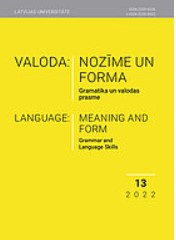Use of posture verbs in old Lithuanian writings: A case study of the verb gulėti ‘lieʼ
Use of posture verbs in old Lithuanian writings: A case study of the verb gulėti ‘lieʼ
Author(s): Agnė KuliešienėSubject(s): Modern Age, Semantics, Historical Linguistics, Lithuanian Literature, Baltic Languages
Published by: Latvijas Universitātes Akadēmiskais apgāds
Keywords: posture verbs; old Lithuanian writings; frame semantics; grammaticalization; verb gulėti ʻlieʼ;
Summary/Abstract: This paper reports on constructions with the posture verb gulėti ʻlieʼ in religious Lithuanian writings of the 16th–19th centuries. The aim of the current study is to offer an overview of the use of these constructions and their grammaticalization potential in the old Lithuanian language. 662 samples were selected from “Evangelijos bei Epistolos” by Bartholomäus Willent, “Ewangelie Polskie y Litewskie” by Jonas Jaknavičius, “Naujos maldų knygelės” and “Naujos giesmių knygos” by Daniel Klein, Johann Jakob Quandt’s Bible and “Naujas įstatymas” by Juozapas Arnulfas Giedraitis. The website “Senieji raštai” (“The old Lithuanian writings”) of the Research Centre of Written Heritage, the Institute of the Lithuanian Language, was utilised to explore the old writings; the constructions were extracted using the search engine of the website. To analyse the semantics of these constructions, the FrameNet system was used. First, the theoretical approach of this study is discussed, and the sources and methods applied are indicated, then, the semantic analysis of the posture verb gulėti ʻlieʼ is presented and finally, its grammaticalization potential is examined, followed by conclusions.
Journal: Valoda: nozīme un forma
- Issue Year: 2022
- Issue No: 13
- Page Range: 139-158
- Page Count: 20
- Language: English

